How Do I Keep My Hydrangea Blue? Easy Tips for Vibrant Blooms
If you want to keep your hydrangeas blue, you’re not alone. These beautiful flowers can add a pop of color to your garden, but getting the right shade takes some work. The secret lies in the soil.
To maintain blue hydrangea blooms, the soil needs to be acidic with a pH level at or below 5.5.
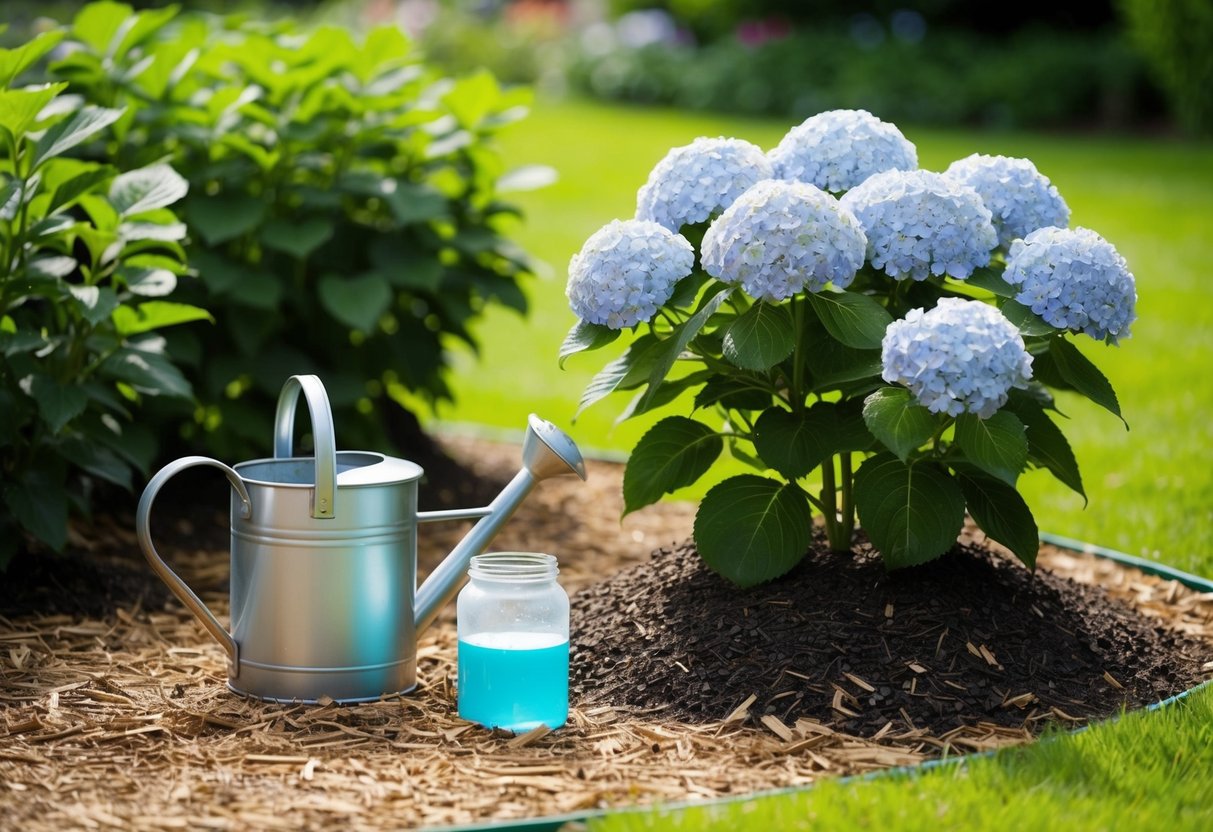
Adjusting your soil’s pH might seem tricky, but it doesn’t have to be. You can start by using soil additives like sulfur.
Consider planting hydrangeas in containers for easier control over the soil pH. Container gardening can help you manage the conditions more effectively when trying to keep your favorite blooms vibrant and blue. Find more details on this technique and other gardening tips by checking out how container planting aids keeping hydrangeas blue.
Watching your flowers change colors can be fascinating, but if your hydrangeas are leaning into pinks and purples, it might be due to less acidic soil. Using rainwater instead of tap water can help, especially if you live in a hard water area where alkaline levels are high. Check out the benefits of avoiding tap water in certain regions to keep your blue hydrangeas bright.
Understanding Soil pH and Its Impact on Hydrangea Colors

Soil pH plays a crucial role in determining the color of hydrangea blooms. Understanding how pH affects your plants can help you achieve the beautiful colors you desire.
The Science of Soil pH
Soil pH measures how acidic or alkaline your soil is. The scale runs from 0 to 14, with 7 being neutral. Values below 7 indicate acidic soil, while values above 7 are alkaline. This balance affects nutrient availability and plant growth.
For hydrangeas, blue flowers are typically produced when the soil is more acidic. Aluminum availability is increased in acidic conditions, which leads to the blue hue.
You can make the soil more acidic by adding elements like sulfur or aluminum sulfate. This can help you achieve vibrant blue hydrangeas.
Monitoring your soil’s pH is important. You can use a pH meter or a simple test kit available at garden centers. Regular checks will help you keep track of changes, ensuring your hydrangeas stay blue.
Acidic vs. Alkaline Soil
Acidic soil is ideal for blue hydrangeas. It typically has a pH between 5.0 and 5.5. This environment allows aluminum to be absorbed by the plant, giving the flowers their blue color. Adding materials like pine needle mulch or coffee grounds can help maintain these acidic conditions.
In contrast, alkaline soil tends to produce pink or purple hydrangeas. With a pH above 7, aluminum is less available, impacting the flower color. To make the soil less alkaline, you can add acidic amendments.
Understanding the differences between acidic and alkaline soils helps you manage hydrangea colors. Soil testing gives you the insights needed to adjust conditions for your desired blooms.
Altering Soil Conditions for Blue Hydrangeas
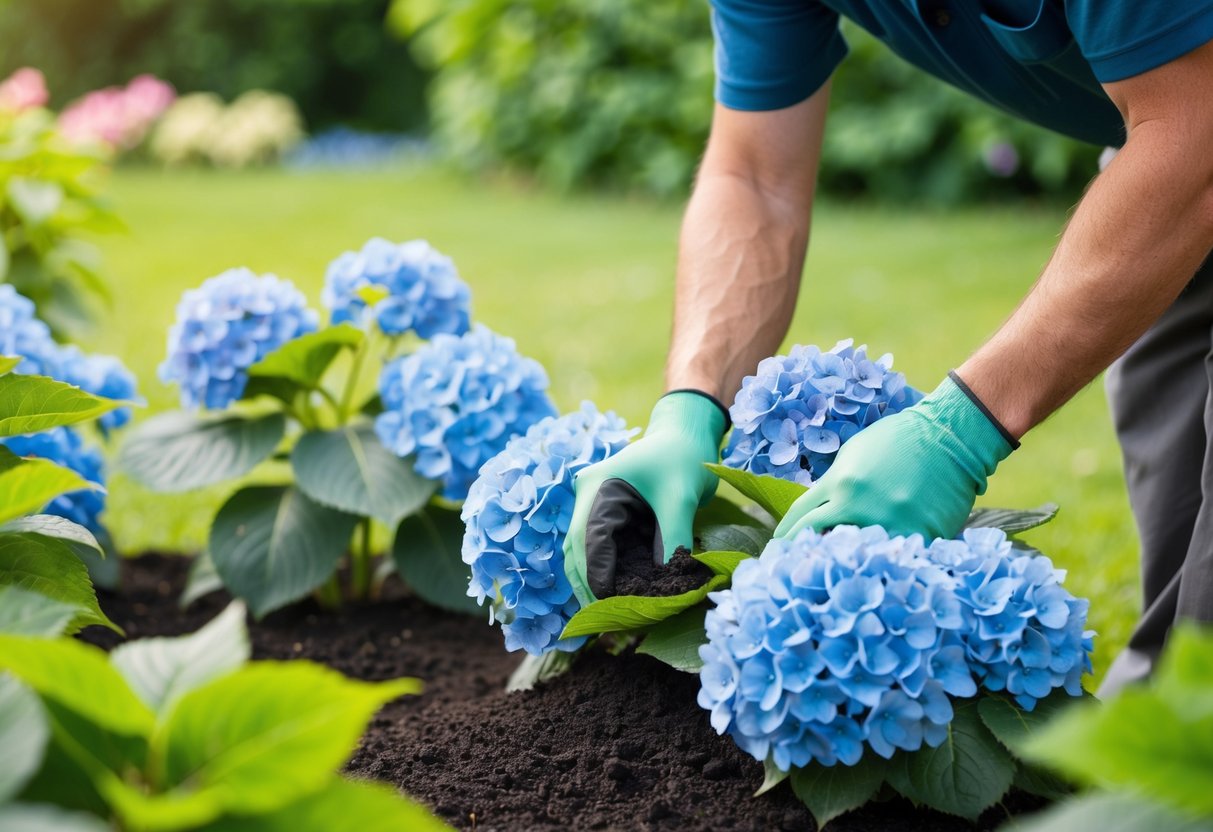
Keeping hydrangeas blue involves modifying the soil to be more acidic. This involves using certain additives and techniques to adjust pH levels and maintain the ideal environment for vibrant blue blooms.
Using Sulfur and Aluminum Sulfate
To ensure your hydrangeas stay blue, you should consider the use of sulfur and aluminum sulfate. These substances help lower soil pH, making it more acidic.
Aluminum sulfate is particularly effective because it delivers both aluminum, which enhances the blue color, and sulfate, which acts as a soil acidifier.
Begin by testing the soil pH. The ideal range for blue blossoms is between 5.2 and 5.5. If your soil is too alkaline, you can mix 1 tablespoon of aluminum sulfate per gallon of water and apply it to the soil throughout the growing season.
You can also sprinkle elemental sulfur around the base of the plant, but remember that this method takes time, as sulfur slowly breaks down into the soil.
Incorporating Organic Matter
Incorporating organic matter such as coffee grounds and organic mulch can naturally increase acidity.
Coffee grounds, for instance, not only enrich the soil but also gradually contribute acidity, making them perfect for acid-loving plants like hydrangeas.
To apply, simply scatter used coffee grounds at the base of your plant and cover them with organic mulch like pine needles or bark. This method not only helps in maintaining acidity but also conserves soil moisture and reduces weeds.
Using leaves and grass clippings can provide slow-releasing nutrients that will benefit your plants over time.
Effective Watering Techniques
Proper watering techniques are key to keeping your hydrangeas healthy and maintaining their color.
Water deeply but less frequently to encourage strong root growth. This means soaking the soil to a depth of at least 6 inches each time you water, which prevents surface roots and ensures the plant receives enough nutrients.
During hot and dry spells, ensure you water your hydrangeas early in the morning or late in the afternoon to reduce evaporation.
Use rainwater if possible because tap water can sometimes contain minerals that increase alkalinity, counteracting your efforts to maintain acidity.
Choosing the Right Hydrangea Varieties
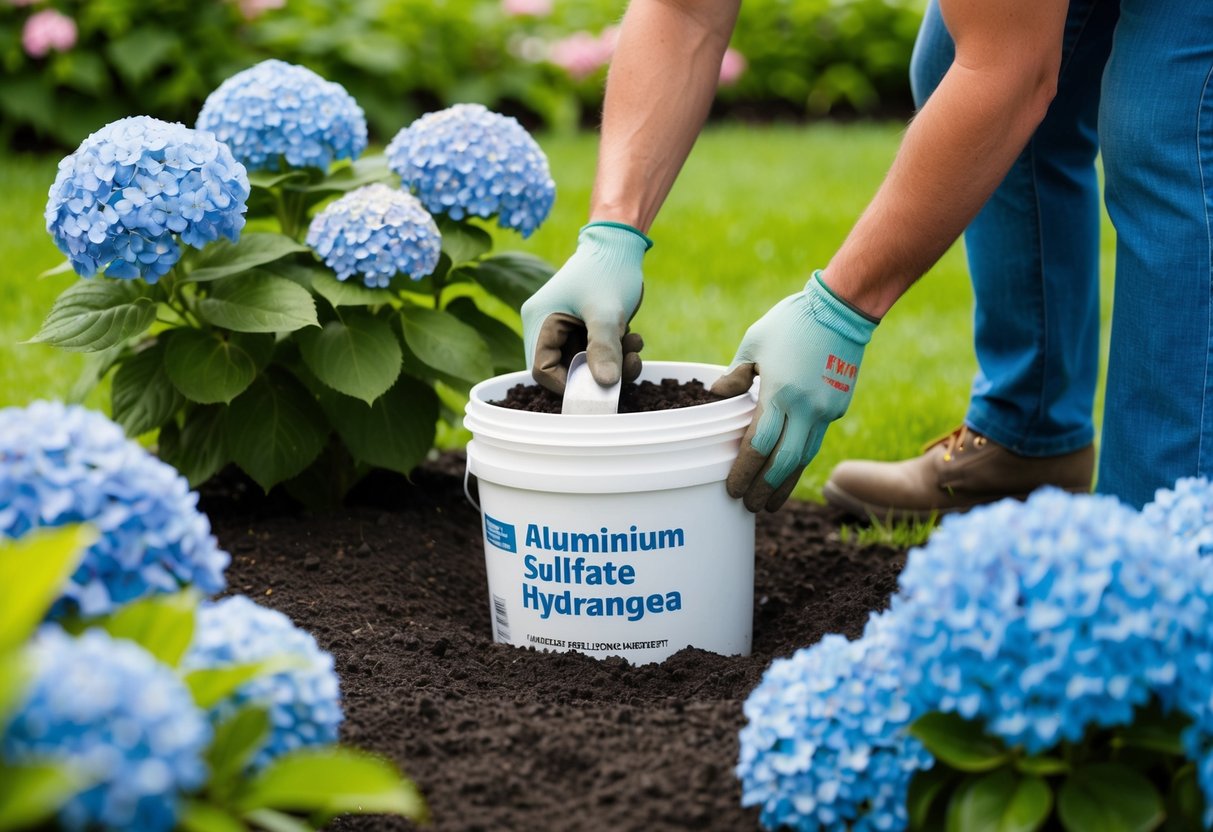
If you want to maintain blue blooms on your hydrangeas, selecting the right varieties is crucial. Some species, like bigleaf hydrangeas, are known for their ability to change color based on soil conditions.
Bigleaf Hydrangeas for Blue Blooms
Bigleaf hydrangeas, also known as Hydrangea macrophylla, are popular for achieving vibrant blue flowers.
Varieties like ‘Nikko Blue’ and ‘Blue Wave’ are excellent choices if you’re aiming for deep blue hues. These types respond well to soil pH adjustments, often turning blue in acidic soils.
You might also consider the ‘Blushing Bride,’ which can develop bluish tints. A fun fact is that altering soil with aluminum sulfate can help maintain the desired blue coloration. Choosing the right bigleaf hydrangea ensures you get the colors you want.
Other Color-Changing Hydrangea Species
Besides bigleaf varieties, some other species can change colors.
Mountain hydrangeas, or Hydrangea serrata, include varieties like ‘Blue Deckle,’ which offer subtle blues. These are especially adaptable to changes in soil pH, making them a versatile choice for gardeners trying to maintain specific colors.
Though not as renowned for color-changing properties, oakleaf hydrangeas can show slight variations.
Choosing these options widens the range of hues in your garden, allowing for a mix of subtle and vibrant blues.
The Role of Mulching and Composting
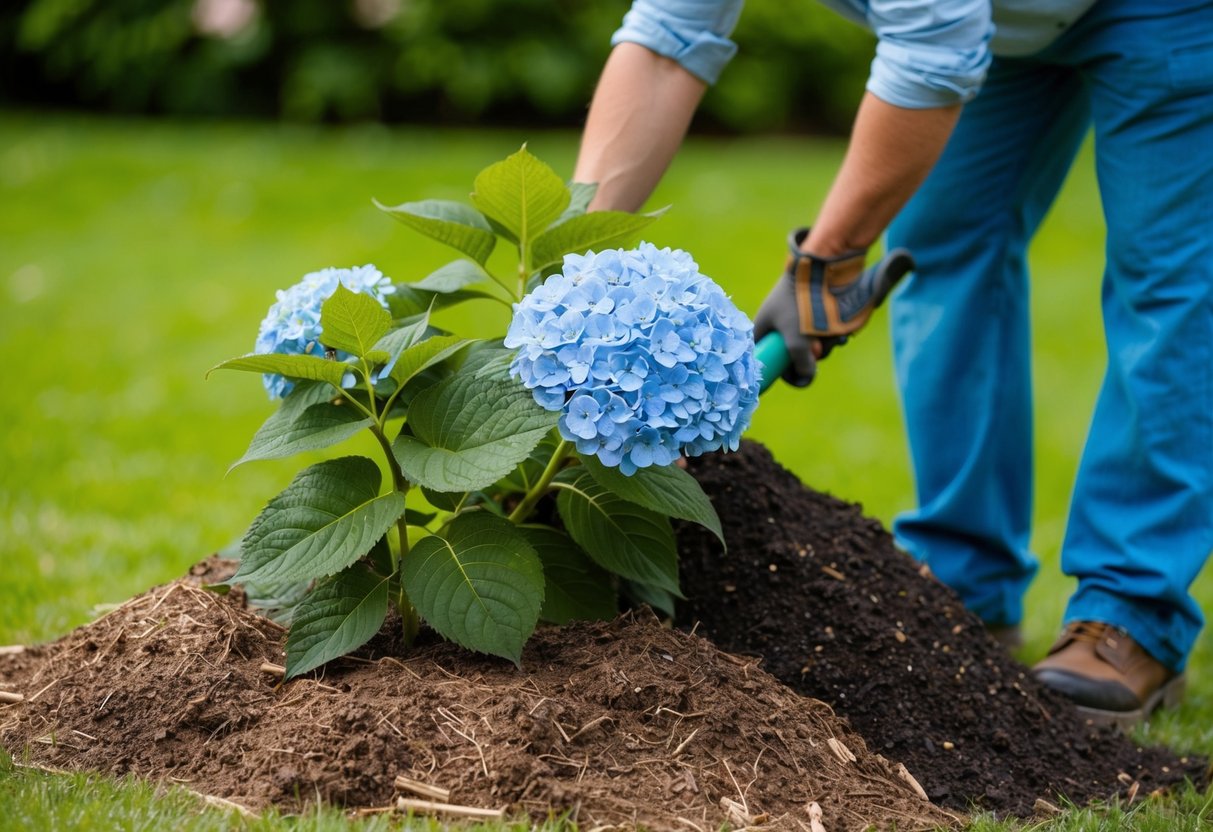
Keeping your hydrangeas blue can be easier with the right mulching and composting techniques. By using special materials, you can maintain the soil’s acidity, which is key for those vibrant blue blooms.
Organic Mulches for Acidifying Soil
Using organic mulch is a great way to make your soil more acidic, which helps keep your hydrangeas blue.
Pine needles are a popular choice because they naturally lower soil pH as they decompose. Spread a layer of pine needles around your plants to start benefiting your soil.
Peat moss is another effective option. It not only helps in maintaining soil acidity but also improves moisture retention.
By adding peat moss, you provide a stable environment for your hydrangeas and reduce the need for frequent watering.
Follow these tips: Keep the mulch about 3 inches away from the stems to prevent any potential rot. Applying fresh mulch each year ensures you maintain the right pH and soil conditions for your hydrangeas.
Composting with Acidic Materials
Composting can also play a big role in maintaining the soil acidity essential for blue hydrangeas.
Incorporate ericaceous compost, which is specifically designed for acid-loving plants, into your soil mix. This type of compost supports the low pH hydrangeas thrive on.
When making your compost, add acidic organic matter like coffee grounds or fruit peels to boost acidity levels.
These materials break down, enriching your compost and contributing to a healthy soil environment.
Be sure to regularly mix and aerate your compost to speed up the breakdown process and distribute nutrients evenly.
Using your homemade, acidic compost can be both a cost-effective and environmentally friendly way to nourish your garden.
Maintaining Blue Hydrangeas Throughout the Season
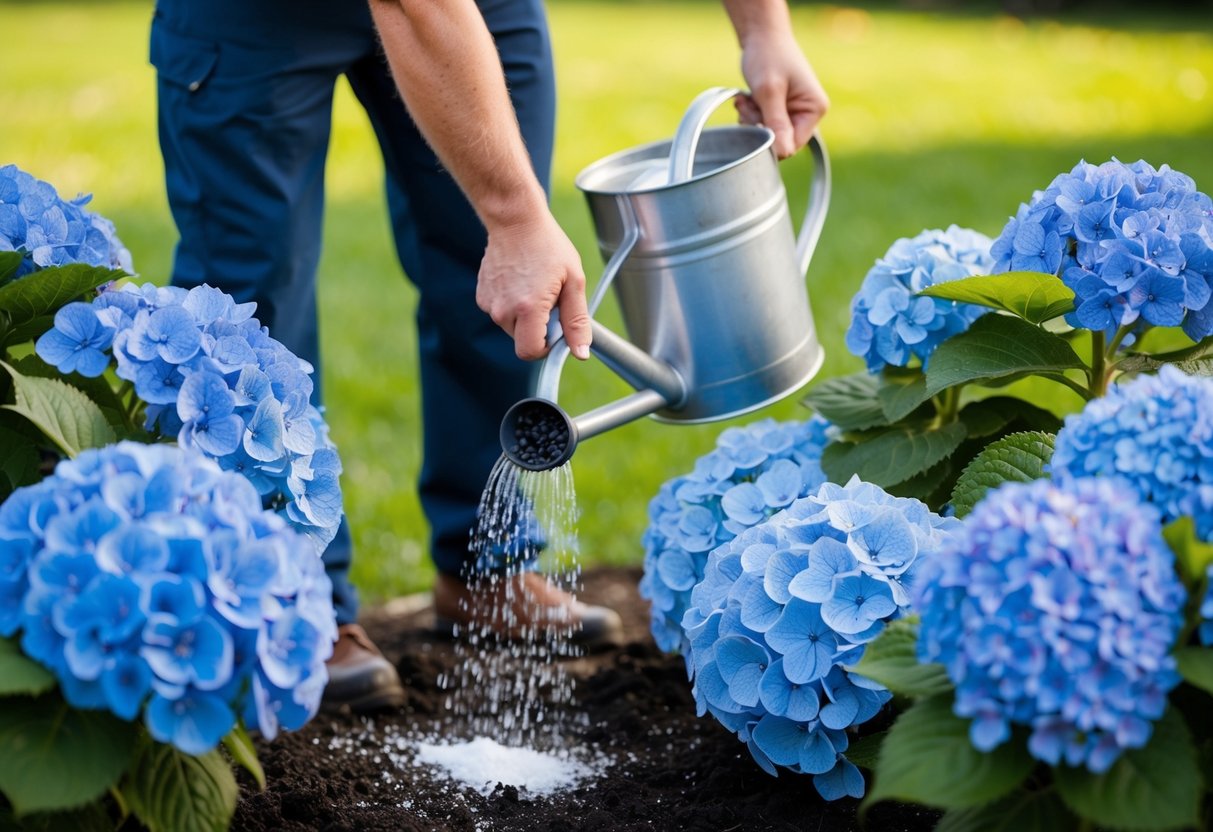
Keeping your hydrangeas blue requires regular attention to soil conditions and specific treatments. The right pH levels and the presence of certain minerals like aluminum sulfate can make a big difference. Here’s how you can manage these factors throughout the growing season.
Regular Soil Testing
To keep your hydrangeas the perfect shade of blue, start with a soil test kit. This will help you check the soil’s pH level.
Look for a pH of 5.5 or lower, which is ideal for producing blue blooms. Testing every few weeks is a good idea because changes in weather can alter soil acidity.
Using rainwater to water your plants can help, as it tends to be more acidic than tap water. If your soil is too alkaline, consider other gardening options like adding some vinegar or lemon juice to gently lower the pH. Just be careful not to overdo it; drastic changes can harm your plants.
Adjusting Treatments as Needed
Once you know the current pH, you can adjust treatments accordingly.
If your soil needs to be more acidic, you could use soil acidifiers or aluminum sulfate. For more immediate effects, try garden lime.
You’ll usually add these treatments in small amounts and test your soil again after some time.
If your hydrangeas start turning pink, it might be a sign that you need to tweak your approach.
Sometimes adding organic materials like pine needles can also help maintain acidity over time.
Keep an eye on your plants, so you can act quickly if something seems off. Regular monitoring will pay off with lovely blue blooms.







